Cloud computing, security or more developers? Here’s where the tech budget is being spent next | ZDNet
We closed the 2020 edition of this article by noting ongoing uncertainty about how the COVID-19 pandemic, and the resulting economic recession, would play out. At the time (August 2020), vaccines were in development but had not yet been deployed (that would not begin until December), and social distancing measures were imposed, with differing levels of stringency, in many countries around the world.
Analyst firm Gartner predicted a recovery of global tech spending in 2021 following a 7.3% slump in 2020, but to a level still 3.3% down on the 2019 (pre-pandemic) figure, with turbulence likely across countries, industries and markets. Important concerns for (US) CEOs in mid-2020 were remote working and supply chain issues, while a leading survey revealed that (North American) companies were in ‘wait and see’ mode regarding IT budgets and new project plans, with early/mid-2020 optimism about the duration of tech spending cuts replaced by a more pessimistic outlook later in the year.
So, how do things look as 2021 heads towards 2022?
Starting with a global view, the UN’s Department of Economic and Social Affairs (DESA) predicts that rapid vaccination rollouts in a few large economies will fuel global economic growth of 5.4% in 2021, following a sharp contraction of 3.6% in 2020 (World Economic Situation and Prospects as of mid-2021, May 2021). This corresponds to an amalgam of DESA’s ‘baseline’ and ‘optimistic’ scenarios from mid-2020, which were -3.2% in 2020/+4.1% in 2021 and -1.4% 2020/+6.1% 2021 respectively.
However, the DESA sounds a note of caution in its mid-2021 bulletin:
While the world economy is treading towards a recovery, the pandemic is far from over for a majority of countries…The stark disparity in vaccination coverage between countries and regions poses a serious risk of an uneven and fragile recovery of the world economy. Timely and universal access to COVID-19 vaccinations will remain a key tool for beating the pandemic and putting the world economy on the path of an inclusive and resilient recovery.
The UK was the first country to deploy COVID-19 vaccine and as of 31 August 2021 had administered two doses to 42.7 million people — 78.6% of the adult population. Easing of lockdown and social distancing measures allowed the economy to grow by 4.8% in the second quarter, with the largest contributions from wholesale and retail trade, accommodation and food service activities, and education. However, the UK’s Q2 GDP is still 4.4% below the pre-pandemic (Q4 2019) level:
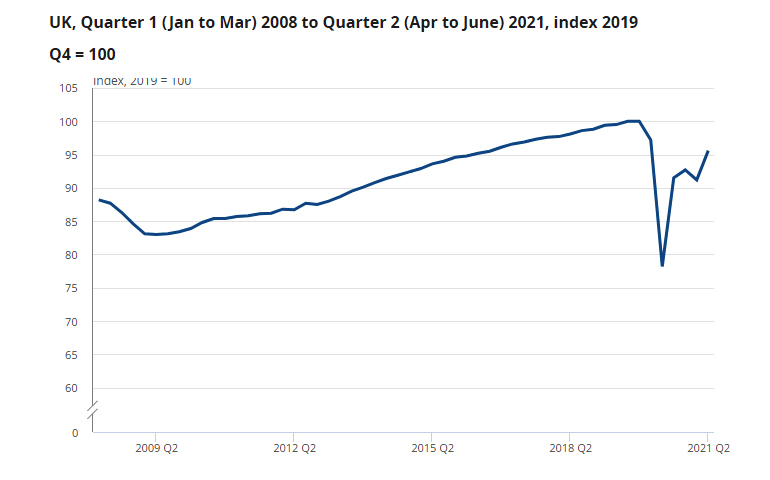
Image: UK Office for National Statistics
What the tech analysts say
According to Gartner’s latest analysis (14 July), worldwide IT spending will total $4.2 trillion in 2021 (8.6% up on 2020), rising to $4.4 trillion in 2022 (5.3% up on 2021). Commenting on the forecast, research vice-president John-David Lovelock highlighted a new ‘build’ phase for IT budgets, in which “CIOs are looking for partners who can think past the digital sprints of 2020 and be more intentional in their digital transformation efforts in 2021. This means building technologies and services that don’t yet exist, and further differentiating their organization in an already crowded market.”
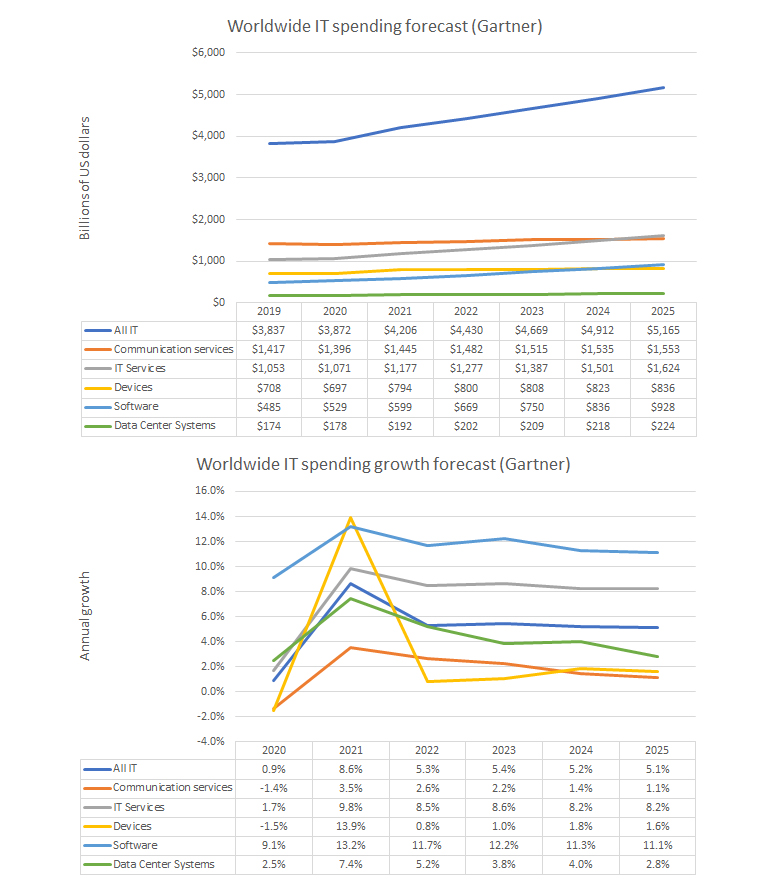
Data: Gartner / Charts: ZDNet
An increased focus on investing in business outcomes as opposed to buying finished products underlies Gartner’s expectations for sustained growth in IT services — 9.8% in 2021, with a CAGR of 8.68% over the 2020-2025 period (second only to software at 11.9%).
“CIOs are turning more and more budget over to application development,” Lovelock explained in an accompanying webinar. “Boards are giving more money to specific digital business transformations. CEOs want IT at the heart of the business value generation of the corporation. And that changes where money comes from, it changes where the money is being spent — there is a new focus on these new areas of build.”
Also noticeable in Gartner’s forecast is a sharp near-$100 billion rise in spending on devices in 2021, most of which is attributable to the rapid shift to remote working during the pandemic, as companies reacted to the initial shock and stabilised their operations.
That reactive phase is now largely over, Gartner says, with most companies preparing to reach the ‘next normal’ — exiting phase 3 of the analyst firm’s COVID response model (‘rebounding to the future’) and moving into phase 4 (‘accelerating opportunities’):
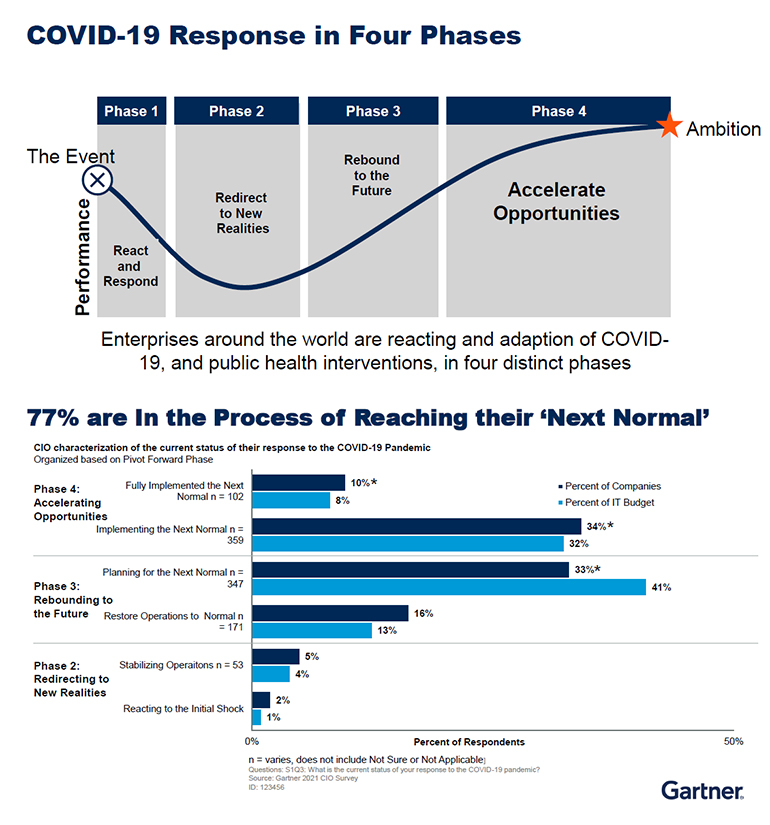
Images: Gartner
These top-level IT spending patterns will be expressed by companies in different market sectors, with different levels of digital transformation and pandemic response, and with different future plans, resulting in the granular real-world figures that we’ll see in future tech budgeting surveys.
What CEOS talked about
Specialist market research firm IoT Analytics has performed a useful quarterly study entitled ‘What CEOs talked about in…” since the start of the pandemic. Metrics are generated from keyword analysis of earnings calls for around 2,500 US-listed companies: one axis plots keyword importance (how many companies mentioned a keyword) and a second plots keyword growth (increase or decrease from the previous quarter, indexed to 100). Here’s the picture for Q2 2021:
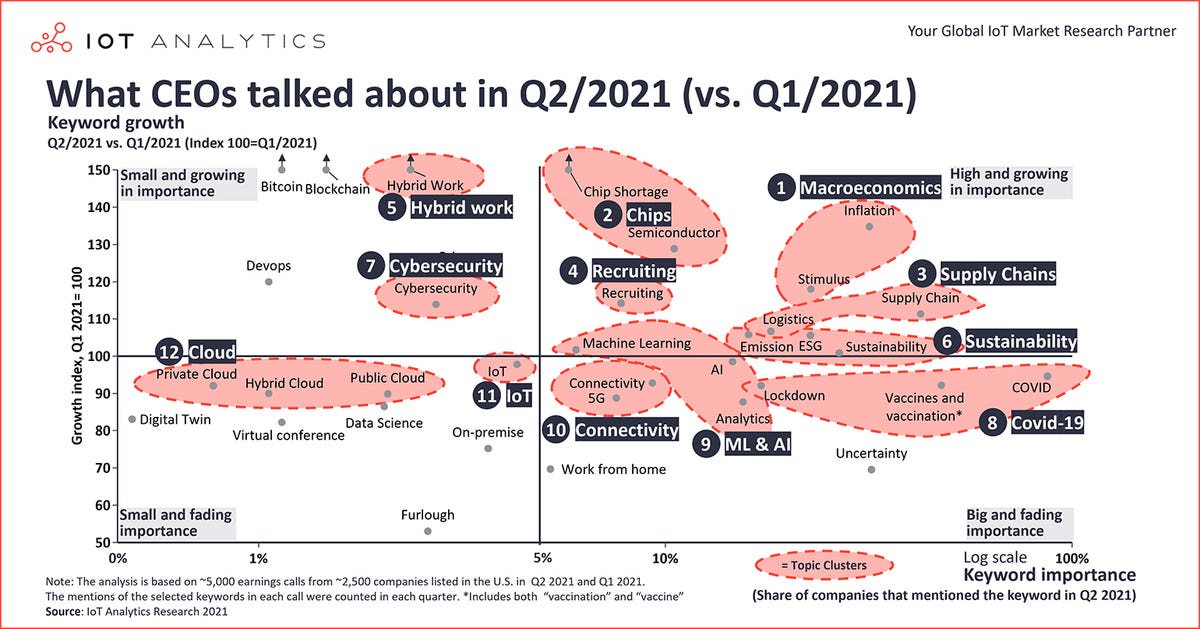
Image: IoT Analytics
Whereas remote work, supply chain issues and security dominated CEOs’ discussions during the same period last year, attention in Q2 2021 turned to macroeconomics (‘inflation’, ‘stimulus’), chips (‘chip shortage’, ‘semiconductor’) plus, once again, supply chains. Remote work had morphed into a new fast-growing buzzword, ‘hybrid work’, which came in at #5 after ‘recruiting’ (see ZDNet’s recent special report Building the digital workforce).
It’s also encouraging to note that ‘sustainability’ has figured in every one of IoT Analytics’ quarterly keyword analyses since Q2 2020, reaching #1 in Q4 2020. However, while sustainability is dutifully mentioned by CEOs in earnings calls, it remains to be seen whether they have the resolve to put their money where their mouth is.
What the IT budgeting surveys say
IT Spending & Staffing Benchmarks 2021/2022 (Computer Economics)
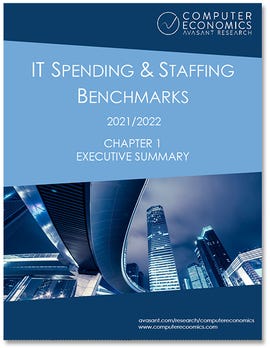
Avasant-owned market research firm Computer Economics has published an annual IT Spending & Staffing Benchmarks report since 1990 and is a valuable source of IT budgeting metrics for North American organisations. The 2021/2022 report was based on survey responses from 234 US and Canadian organisations between January and May 2021 — 34% small (IT operational budget <$5m), 33% mid-size ($5m-<$20m) and 33% large (>$20m). Leading industry sectors in the survey sample were manufacturing (21.8%), professional/technical services (19.2%) and government/nonprofit (13.2%).
The overall picture from Computer Economics’ latest survey is one of a “remarkable bounce-back” from a global pandemic that “short-circuited nearly a decade of steady growth”:
Three-quarters of companies this year are poised to increase their IT operational budgets, a record in the cloud era. Organizations across nearly every sector and company size are planning IT budget increases in line with pre-COVID-19 economic conditions. Given that IT staff head counts have not increased significantly over the past decade due to the efficiencies brought on by the cloud, software as a service (SaaS), and automation, it is a further sign of a rebounding economy that a majority of IT organizations are planning modest head count growth. We continue to see expected increases in spending on digital transformation, SaaS, cloud infrastructure, and data analytics, indicating that IT organizations are not holding back on new investments, and they see a clear path toward a digital future.
That said, the market research firm identified some potential blots on the horizon, including: IT skills shortages (leading to greater incentives for automation); inflation (causing seemingly adequate IT budget increases to prove insufficient); and residual pandemic effects (companies forced to cut IT budgets in 2020 are now playing catch-up).
Here’s a summary of Computer Economics’ 2021/22 findings, with the previous year’s figures for comparison:
|
Computer Economics |
2021/2022 |
2020/2021 |
|
IT operational spending growth |
3% |
3% |
|
Net % of companies increasing IT operational spending |
59% |
54% |
|
IT operational spending growth by company size (small / medium / large) |
2.5% / 3% / 3% |
3% / 3% / 3.3% |
|
CIO view on IT budget adequacy (inadequate / adequate) |
51% / 49% |
44% / 56% |
|
Total IT spending as % of revenue |
2.5% |
2.6% |
|
IT operational spending per user |
$7,878 |
$7,705 |
|
Leading sectors for IT operational spending growth |
prof/tech services (4.6%), construction/trade services (4.5%) |
prof/tech services (5%), manufacturing (3%) |
|
% of companies increasing / decreasing IT capital budgets |
53% / 19% |
48% / 31% |
|
Capital budget as % of total IT spend |
17% |
17% |
|
Top IT spending priorities |
cloud apps, cloud infrastructure, data analytics/BI |
cloud apps, cloud infrastructure, data analytics/BI |
|
% of companies with at least 75% of software spending on cloud subscriptions |
19% |
11% |
|
Top priorities for increased IT spending (net % of companies) |
information security/privacy (81%), business applications (73%) |
information security/privacy (76%), business applications (75%) |
|
% of companies increasing / decreasing IT headcount |
53% / 22% |
52% / 14% |
It’s noteworthy that companies’ top IT spending priorities (cloud apps, cloud infrastructure, data analytics/BI) and top priorities for increased spending (information security/privacy, business applications) have not changed between this year’s and last year’s surveys. Notable increases were: the percentage of CIOs viewing their IT budget as inadequate (51% in 2021/22, 44% in 2020/21); the percentage of organisations increasing their IT capital budgets (53% vs 48%); and the proportion of companies with at least 75% of their software spending allocated to cloud subscriptions (19% vs 11%).
Computer Economics notes that the continuing trend for more digital transformation has made companies more flexible and resilient in the face of the recession, strengthening business continuity and improving productivity. In fact, the report goes so far as to describe technology’s role in the rapid recovery from the pandemic as “nothing short of a miracle”.
Going forward, Computer Economics suggests that the “low-hanging fruit” in cloud migration is now picked, and that “We are now in the stage of digital transformation where we are not just replacing existing tools — we are now enhancing them.” That will require more investment in technology and people, the report says, although the amount “will be difficult to predict”.
Flexera 2021 State of Tech Spend Report
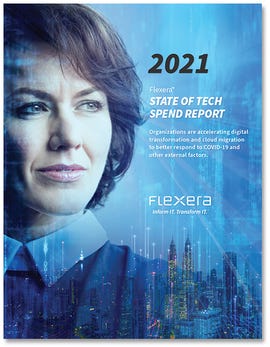
SaaS-based IT management software vendor Flexera began publishing its State of Tech Spend Report in 2020, releasing findings from its second edition in January 2021. Flexera canvassed 474 enterprise CIOs and IT executives in organisations based in North America (68%) and Europe (32%) with at least 2,000 employees. A majority (52%) worked in large companies (>10,000 employees), with equal proportions (24%) in medium-sized (5,001-10,000 employees) and small (2,000-5,000 employees) organisations. A wide range of industry sectors were represented in the survey, headed up by financial services (19%) and retail & e-commerce. (11%).
Like Computer Economics, Flexera highlights the importance of digital transformation in companies’ responses to, and emergence from, the pandemic:
The report highlights the noteworthy and sometimes dramatic shifts since last year’s report was published. The COVID-19 pandemic has proven to be a game changer. It’s forced organizations to accelerate digital transformation efforts to support major changes in how and where people work and to mitigate negative impacts of the economic downturn. Nearly half of IT staff members now work from home. Time frames for returning to the office are uncertain. And 20 percent of people who are now working at home will do so permanently after the pandemic ends.
The pandemic has made for a challenging and interesting year. As difficult as the year’s been, however, the rapid progress toward becoming a digital enterprise will likely pay off substantially in 2021 and beyond.
Here’s a summary of Flexera’s 2021 findings, with the previous year’s figures, where available, for comparison:
|
Flexera |
2021 |
2020 |
|
Top IT initiatives |
digital transformation (56%), cybersecurity (50%), cloud/cloud migration (48%) |
digital transformation (54%), cybersecurity (49%), cloud/cloud migration (40%) |
|
Expected increase in digital transformation pace (significantly / somewhat) |
40% / 46% |
n/a |
|
Top factors impacting organizations due to the pandemic |
work from home (74%), lower revenue/profits (51%), general economic downturn (50%) |
n/a |
|
Impact of pandemic on digital transformation pace |
work from home (54%), increased willingness to move to cloud (42%) |
n/a |
|
% of companies with IT spend over $250m |
33% |
39% |
|
IT spend as % of revenue (overall / Americas / Europe) |
7.5% / 8.5% / 6% |
8.2% / 9.1% / 6.7% |
|
IT spend as % of revenue (small / medium / large) |
8% / 10% / 5% |
8.3% / 5.3% / 9.3% |
|
IT spend as % of revenue (top industry sectors) |
software (15%), tech hosting/cloud (10%), financial services (10%) |
software (24.7%), tech hosting/cloud (15.5%), financial services (10%) |
|
% of companies expecting increase in IT spend (overall / Americas / Europe) |
49% / 49% / 50% |
56% / 57% / 52% |
|
IT investment in growth vs running the business |
36% / 64% |
n/a |
|
IT spend controlled by IT vs business units |
74% / 26% |
74% / 26% |
|
% of IT spend on cloud software & services |
30% |
25% |
|
% of companies planning to significantly reduce or eliminate data centres |
34% |
33% |
|
Top categories experiencing IT spending increases due to COVID-19 |
SaaS, public cloud, desktops/laptops, network |
n/a |
|
Top categories for IT spending increases in 2021 |
automation, SaaS, public cloud, AI/ML |
n/a |
|
IT involvement with business strategy |
equal partner (20%), stakeholder (25%), validator (20%), implementer (35%) |
n/a |
|
% wasted IT spend (respondent estimate / independent estimate) |
12% / 30% |
12% / 30% |
|
Top IT spending visibility challenges |
reporting by business service, technology visibility for on-prem, SaaS & cloud |
reporting by IT business service, collecting IT spend data |
|
Top IT decision-making challenges |
lack of good-quality data, slow decision implementation |
n/a |
|
Top IT spend optimisation challenges |
too many manual processes, understanding cost of delivered IT services |
too many manual processes, ensuring spend efficiency (avoiding waste) |
|
Top areas for maturity of IT spend optimisation |
software licence compliance, software licence spend |
software licence compliance, software licence spend |
|
Largest technology vendor |
Microsoft (47%), AWS (22%), Oracle (6%) |
Microsoft (43%), SAP (13%), AWS (10%) |
|
% of respondents expecting increases in vendor spend |
Microsoft Azure (61%), Microsoft SaaS (57%), AWS (54%) |
AWS (65%), Microsoft (56%), ServiceNow (48%) |
|
% full-time remote IT staff (due to COVID / not due to COVID) |
45% / 12% |
n/a |
|
Remote IT staff return to office (beyond mid-2021 / never) |
20% / 19% |
n/a |
|
Top planned increases to IT staff investments |
remote workers (79%), upskilling of existing employees (68%), reskilling of existing employees (59%) |
n/a |
|
Top planned increases in external IT resources |
cybersecurity (63%), big data/analytics (59%), automation (57%) |
n/a |
Also like Computer Economics, Flexera found no change in the top IT priorities between its 2020 and 2021 surveys, with digital transformation, cybersecurity and cloud/cloud migration the leading initiatives in both years. However, further down the list, in a likely reaction to the pandemic, citing of ‘cost savings’ tripled from 9% in 2020 to 27% in 2021. CIOs and IT executives may be giving more weight to cost savings this year, but their estimates of wasted IT spend remain constant at 12%, and consistently below independent estimates of 30%.
Several other metrics remained steady from year to year, including the balance between IT and business units when it comes to control over IT spend (74% versus 26% in 2021 and 2020), and the percentage of companies planning to significantly reduce or eliminate data centres (34% in 2021, 33% in 2020). Pandemic-related effects include widespread expected increases in the pace of digital transformation (86% somewhat or significantly), driven particularly by working from home and an increased willingness to move to the cloud. At the time of Flexera’s 2021 survey, one in five companies thought their remote IT staff would not return to the office until after mid-2021, while a similar proportion (19%) thought they never would.
Flexera signs off its 2021 report by noting that although the drivers of digital transformation are unchanged, “the pressure to fast-track digitization increased dramatically with the emergence of COVID-19…causing organizations to shift gears with respect to timelines and IT spend allocations”.
“As disruptive as 2020 was,” Flexera concludes, “the long-term advantages of earlier digital transformation are likely to lead to enhanced business success over the next few years”.
Outlook
Although the COVID-19 pandemic is far from over (especially in less developed parts of the world where vaccine roll-outs lag far behind the G7 nations), there are definite signs of recovery from the pandemic-driven recession of 2020/21. These green shoots are apparent at the global macroeconomic scale, and also in the responses of individual businesses.
After a burst of spending on devices in 2020/21 to cope with the widespread pivot to remote working, worldwide IT spending is set to grow steadily at just over 5% per year for the next few years, with IT services and software showing the biggest increases as CIOs allocate ever more budget to custom application development aimed at specific business outcomes.
Surveys highlight how digital transformation has helped companies become more flexible and resilient in the face of the recession, leaving them better placed to prosper in the post-pandemic era.
For all the latest Technology News Click Here
For the latest news and updates, follow us on Google News.
